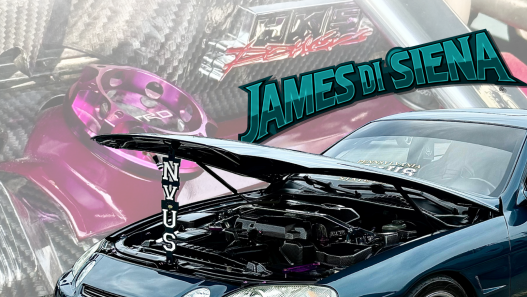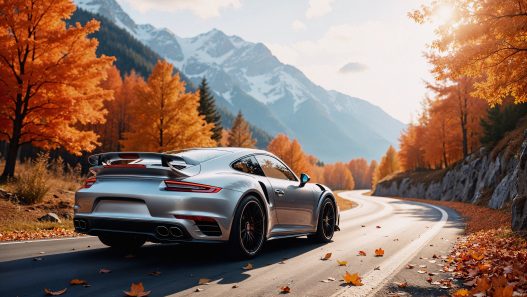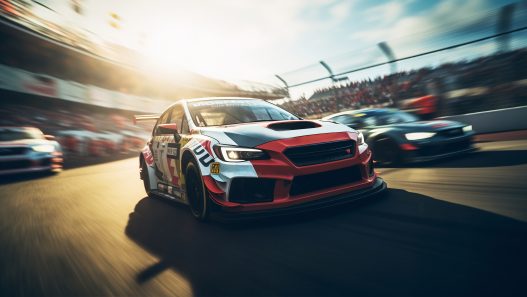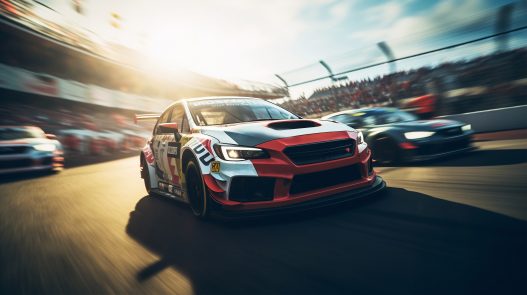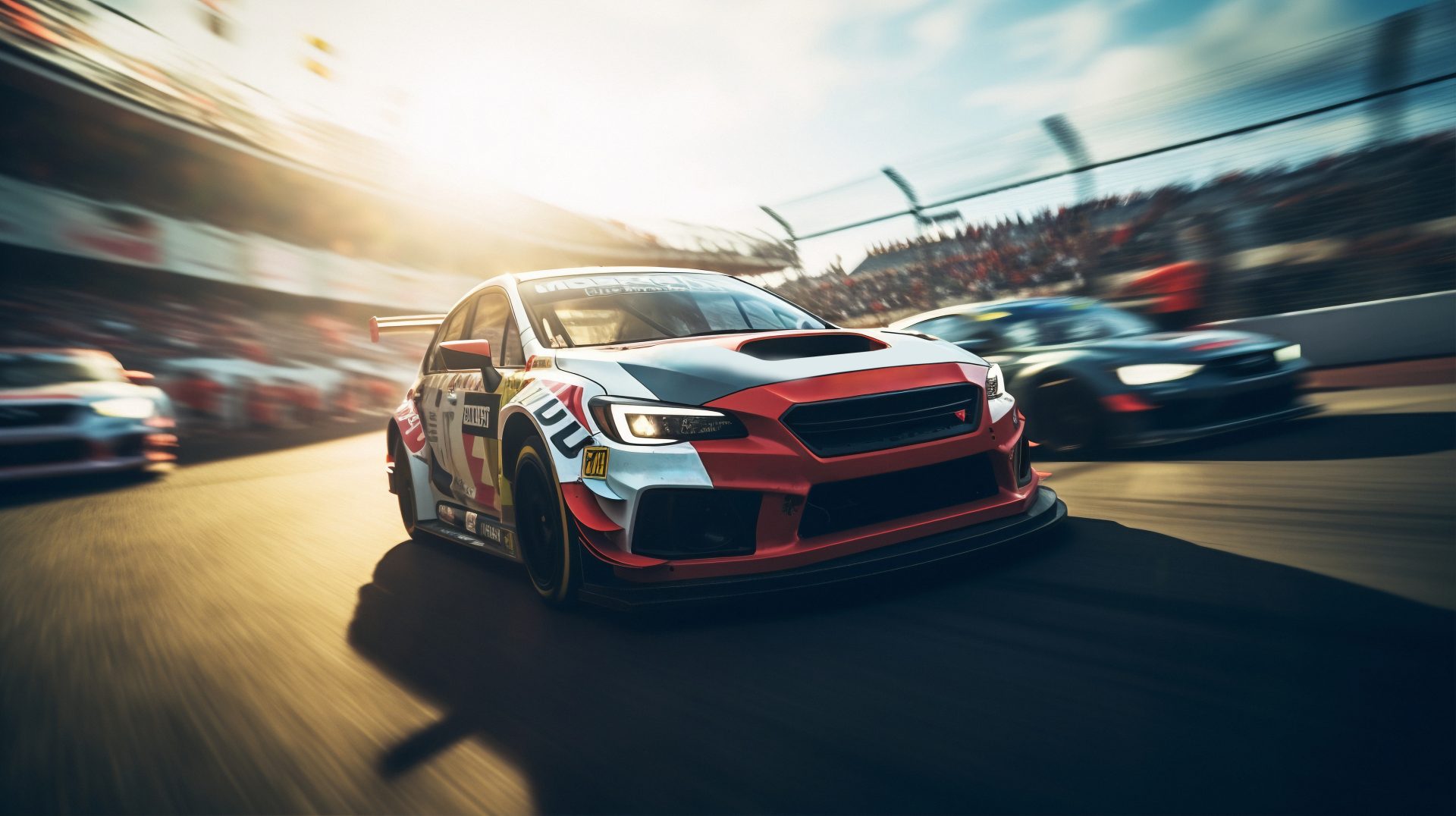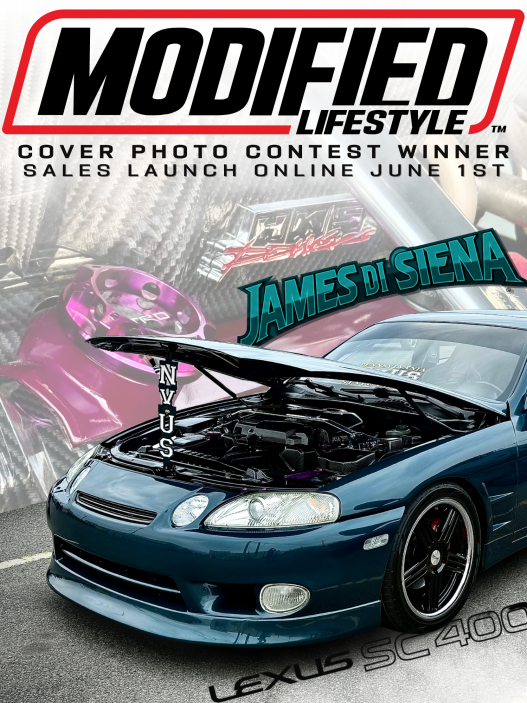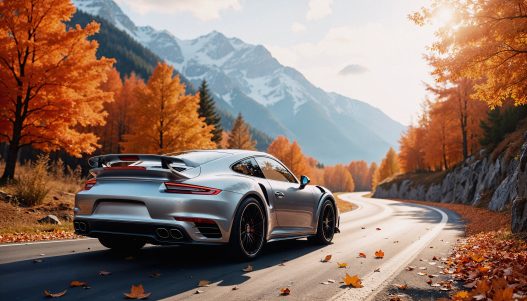The Roar of Individuality
Imagine the scene: tire smoke billowing as a car dances sideways, the explosive launch of a highly tuned import leaving the line, the surgical precision of a winged machine slicing through a corner. These are the sounds and sights that define a unique corner of the automotive world. For enthusiasts immersed in the modified car lifestyle, motorsport transcends mere competition. It’s a visceral extension of the passion for building, tuning, and personalizing vehicles. It’s not just about the win; it’s about the statement made by the machine, the skill displayed behind the wheel, and the unique style brought to the track.1 This is where raw speed converges with radical self-expression.
Defining Motorsports for the Modified Lifestyle
While the world stage features titans like Formula 1 and NASCAR, the heartbeat of the modified scene often resonates more strongly with different forms of automotive competition. This guide focuses on the motorsport disciplines that capture the imagination and participation of those who live and breathe modified cars: the controlled chaos of Drifting, the straight-line fury of Drag Racing (particularly the import and street-focused varieties), the lap-time obsession of Time Attack, the accessible precision of Autocross and Gymkhana, and the learning environment of Track Days or High Performance Driver Education (HPDE).2
The unifying element across these disciplines is their connection to the core tenets of the modified lifestyle. These are arenas where vehicle modification isn’t just permitted; it’s often fundamental to the culture and the competition itself.6 Publications like Fast Car, NZ Performance Car, Import Tuner, DUB Magazine, and Stance Auto Magazine reflect this vibrant culture, showcasing the builds, the events, and the personalities that define it.11
The Genesis: How Modifying Cars Ignited a Unique Motorsport Passion
From Back Alleys to Battlegrounds: The Roots of Modified Motorsports
The need to make cars faster, handle better, and look unique is deeply ingrained in automotive history. The spirit of early American hot-rodding and drag racing, characterized by engine swaps, stripped-down bodies, and a relentless pursuit of speed, laid the groundwork.2 However, a distinct branch of motorsport passion emerged with the rise of the import scene.
Southern California in the 1970s and 1980s became a crucible for this movement. Young Asian-Americans, including first-generation “Issei” immigrants from Japan and Okinawa, played a pivotal role.20 They began modifying compact, affordable Japanese imports like the Datsun 510, Honda Civic, Toyota Celica and Corolla, and Mazda RX-series cars.20 Drawing inspiration from trends in Japan, they customized paint, exhausts, and engines, congregating in places like the Meiji Market parking lot in Gardena, CA, which became an early hub for this burgeoning culture.20 This wasn’t merely about transportation; it was about identity and community, expressed through automotive modification.
Before the Japanese wave fully crested, modified Volkswagens, particularly Beetles, had already carved out a niche in drag racing during the 1960s and 70s, challenging the V8 establishment and proving that ingenuity could compete with displacement.20 This spirit of modifying accessible, often overlooked platforms carried directly into the import scene. As the popularity of modified Japanese cars grew, so did the informal street racing and meet-up culture, spreading to nearby cities and eventually leading to large-scale, organized drag events.20
The Cultural Accelerants: Media, Games, and Global Influence
The import modification scene, and the motorsport styles associated with it, exploded into mainstream consciousness in the late 1990s and early 2000s. Major cultural forces acted as powerful accelerants. Blockbuster films like The Fast and the Furious series showcased highly stylized import cars engaged in street racing and drifting, capturing the imagination of a global audience.20 Simultaneously, video game franchises like Need for Speed: Underground allowed players to virtually build and race the very cars gaining popularity on the streets, further cementing the aesthetic and performance ideals of the scene.20
Magazines dedicated to this niche, such as Import Tuner, Sport Compact Car, and Super Street, became essential reading, shaping trends, featuring influential builds, and documenting the growing motorsport disciplines like import drag racing and drifting.2 These publications provided inspiration and technical guidance, fostering a sense of community among enthusiasts.
The development of the “import scene” was therefore more than just an automotive trend; it represented a cultural phenomenon. It was driven by a desire for personalization, heavily influenced by Japanese automotive aesthetics and tuning philosophies, and significantly amplified by mainstream media.20 This cultural backdrop is crucial to understanding why disciplines like import drag racing and drifting, which emphasize style and specific vehicle platforms (Honda, Nissan, Toyota, Mazda 20), evolved with a different flavor compared to more established forms of motorsport. The focus often extended beyond pure competition to encompass the artistry of the build and the identity of the community.11
Drifting: Mastering the Sideways Spectacle
More Than Speed: The Art and Soul of Drifting
Drifting stands apart in the motorsport world. It’s a judged discipline where the stopwatch takes a backseat to style, car control, angle, and the sheer spectacle of maneuvering a car sideways through a marked course at high speed.1 Often described with artistic analogies like the “ballet or figure skating of motorsports” 28, its core appeal lies in a unique blend of elements: the visual drama of smoking tires and extreme angles, the breathtaking skill required from the driver, the creativity expressed through wildly modified vehicles, and the captivating dance between aggression and finesse.1
From Touge Roots to Global Stages: The Evolution of Drift
The origins of drifting as a specific technique can be traced back to 1970s Japan and racer Kunimitsu Takahashi. Competing in series like the All Japan Touring Car Championship, Takahashi developed an aggressive style of intentionally oversteering into corners before the apex to overcome the limitations of tire technology at the time, winning fans with his spectacular approach.3 This technique was adopted and refined by street racers on Japan’s winding mountain roads, known as touge. Figures like Keiichi Tsuchiya, who honed his skills on the touge before transitioning to professional racing, became instrumental in popularizing drifting as a distinct discipline, earning him the title “Drift King”.29
From these Japanese roots, drifting spread globally, significantly boosted by media portrayals in anime like Initial D, films like Fast and Furious: Tokyo Drift, and video games.23 This exposure led to the formation of amateur and professional drifting series worldwide, including the influential Formula Drift (FD) championship launched in the United States in 2004.26 Today, sanctioned drift events occur across the globe, uniting diverse cultures under the shared thrill of controlled slides.23
The Machines: Icons of the Sideways Scene
While theoretically possible in many cars, drifting heavily favors rear-wheel-drive (RWD) platforms known for their balance, responsiveness, and aftermarket support.3 Certain models have achieved iconic status within the drift community:
- Nissan S-Chassis: The Silvia (S13, S14, S15) and its North American counterpart, the 240SX, are arguably the quintessential drift platforms due to their affordability, tunability, and ideal handling characteristics.30
- Toyota AE86 Corolla: A lightweight, balanced legend, immortalized by Initial D and revered by purists.1
- BMW 3-Series (E30, E36, E46): Offering excellent chassis dynamics and readily available parts, these BMWs are popular choices for beginners and experienced drifters alike.30
- Mazda RX-7 (FC3S, FD3S): Known for their lightweight rotary engines and superb balance.1
- Ford Mustang (S197, S550): American muscle brings ample torque and RWD prowess, gaining significant traction in drifting in recent years.29
- Nissan Z-Cars (350Z, 370Z): Capable RWD platforms with strong aftermarket support.
Achieving competitive or even enjoyable drifting performance necessitates specific modifications:
- Suspension: This is paramount. Adjustable Coilovers are fundamental for tuning ride height, damping, and spring rates to control weight transfer.30 Angle Kits are critical, especially at higher levels, replacing stock steering components to achieve significantly increased steering lock (over 70 degrees is possible with kits like those from SLRspeed), allowing for deeper angles and better control during transitions.26 Suspension Reinforcement, including upgraded control arms (often from stronger materials like chromoly), stiffer bushings (polyurethane or solid), and adjustable sway bars, is crucial to withstand the intense forces involved and provide precise feedback.30
- Drivetrain: A Limited Slip Differential (LSD) is non-negotiable for consistent drifting. It ensures power is sent to both rear wheels even when one loses traction, allowing the driver to maintain the slide.30 While professional setups use sophisticated clutch-type or helical LSDs, a welded differential (locking the rear wheels together permanently) is a common, albeit less refined, budget modification for grassroots cars.
- Brakes: While not used for slowing down in the traditional sense mid-drift, brakes are vital for initiation and adjustment. Upgraded brake pads and high-temperature fluid are needed to handle the heat generated.34 A Hydraulic Handbrake provides much stronger and more immediate rear wheel locking than a stock cable handbrake, essential for precise initiation and corrections.34 Advanced setups may use Dual Rear Calipers, dedicating one set solely to the handbrake.34
- Safety: As speeds and risks increase, safety becomes critical. A Roll Cage (built to FIA specifications for professional competition like Formula Drift 26) provides structural rigidity and rollover protection. A proper Racing Seat and Multi-Point Harness keep the driver securely in place.26 A Fire Suppression System is mandatory at higher levels.26
- Other Modifications: Weight Reduction improves agility and responsiveness; removing unnecessary interior components and using lightweight panels (like carbon fiber) is common.30 Engine Modifications vary widely. While Formula Drift cars often boast over 1,000 horsepower 26, reliable power delivery and throttle response are often prioritized over peak numbers, especially when learning. Engine swaps (like GM LS V8s or Toyota JZ engines) are frequent in many platforms.30
It’s important to recognize that while professional drifting showcases extreme power and complex builds, the foundation of drifting lies in car control and fundamental modifications. Grassroots participants and beginners often find more success and enjoyment by focusing on reliability, seat time, and core upgrades like coilovers, an LSD, and potentially an angle kit, rather than chasing the massive horsepower figures seen in professional ranks.30 The journey typically starts with mastering the basics in a well-prepared but not necessarily overpowered vehicle.
Key Techniques Demystified
Initiating and controlling a drift involves manipulating the car’s balance and traction. Here are the fundamental techniques:
- Clutch Kick: A quick depression and release of the clutch pedal while under power momentarily disconnects and then abruptly reconnects the engine to the drivetrain. This “kick” sends a shock through the rear wheels, breaking traction and initiating a slide.37 It’s effective for lower-horsepower cars or for making quick angle adjustments mid-corner. The duration of the clutch depression can be varied (“small” vs. “big” clutch kick) to control the intensity based on the car and corner.38
- E-Brake (Handbrake) Initiation: Pulling the handbrake (while depressing the clutch in a RWD car) locks the rear wheels, causing the car to rotate into a slide.37 Once the desired angle is achieved, the handbrake is released, the clutch is re-engaged, and throttle is applied. This is particularly useful for initiating drifts in tighter corners or for correcting a line.
- Power Oversteer: In a sufficiently powerful RWD car, aggressively applying the throttle mid-corner can overwhelm the rear tires’ grip, causing them to spin and initiate a drift.37 This technique relies heavily on having enough torque and horsepower available.
- Feint Drift (Scandinavian Flick): This technique uses weight transfer. The driver momentarily steers away from the corner, then quickly snaps the steering back into the corner. This rapid change in direction shifts the car’s weight, unsettling the rear end and inducing a slide.37
- Brake Drift: Applying the brakes while turning into a corner shifts weight onto the front tires, increasing their grip while simultaneously reducing the load (and grip) on the rear tires, making it easier for the rear to slide.37 This can involve trail braking (gradually easing off the brakes while turning) or a sharper application on entry.
Once the drift is initiated, counter-steering (steering in the opposite direction of the slide) and precise throttle modulation are crucial for maintaining control, adjusting the angle, and sustaining the drift through the corner.37 Understanding and manipulating weight transfer through braking, acceleration, and steering inputs is fundamental to fluid, controlled drifting.37 Techniques like heel-toe downshifting can be employed during braking phases to select a lower gear smoothly, keeping the engine in its powerband for exiting the corner or maintaining the drift.39
The Scene: Grassroots Energy vs. Pro Polish
The world of drifting encompasses a spectrum of participation, from informal practice days to highly structured professional championships.
- Grassroots Drifting: Characterized by its accessibility, community focus, and emphasis on fun.31 Events are often held at local tracks or dedicated skidpads. The atmosphere is typically welcoming and supportive, with a wide variety of cars participating – from budget-built “missiles” (cars intended for hard driving with less concern for cosmetics) to meticulously prepared street and track cars.31 Rules are generally less strict, prioritizing seat time and enjoyment over intense competition.31
- Professional Drifting (Formula Drift): This represents the pinnacle of the sport in North America.26 Formula Drift (FD) features judged tandem battles, where two drivers navigate the course simultaneously, one leading and one chasing, then switching roles.26 Competition is fierce, teams are professional, budgets are significant ($80k-$200k+ for a competitive car build 26), and the rulebook is extensive, covering everything from chassis modifications to tire specifications and mandatory safety equipment (FIA-spec cages, fire suppression, etc.).26
Formula Drift Judging Explained: Success in FD hinges on impressing a panel of judges who evaluate runs based on specific criteria 26:
- Line (30 points): Adherence to a pre-determined path marked by inner clipping points (which the front of the car should get close to) and outer zones (which the rear of the car should fill).27
- Angle (30 points): The degree of sideways angle maintained throughout the course, relative to the track’s direction. Consistency and maximizing angle in appropriate sections are key.27
- Style (40 points – Fluidity & Commitment): This encompasses the overall execution. Fluidity refers to the smoothness of transitions between drifts, how quickly angle is achieved, and the absence of corrections or hesitations. Commitment relates to the driver’s confidence, aggression, speed, and proximity to track boundaries or walls, especially on initiation and through challenging sections.27
The chase driver in a tandem battle is judged on their ability to mimic the lead driver’s line and angle while maintaining close proximity.
This formalized judging system directly shapes car development and driving styles at the professional level. The need to hit specific lines at extreme angles, for instance, drives the development and adoption of high-angle steering kits.26 While visually stunning, this structured approach can sometimes differ from the more freeform expression seen in grassroots drifting, where individual style might take precedence over hitting precise marks.27
Key figures who have shaped or starred in professional drifting include pioneers like Stephan Papadakis 18 and international legends like Daigo Saito.29 Modern Formula Drift stars include multiple champions like James Deane 29, Fredric Aasbø 28, Vaughn Gittin Jr., and Chelsea DeNofa, alongside rising talents like Hiroya Minowa 47 and unique personalities like the masked driver RAWRI.26 The series attracts a diverse international field, with drivers from Ireland, Japan, Norway, Canada, and more competing.35
Get Sideways: Your First Steps into Drifting
For those inspired to try drifting, the path typically starts at the grassroots level:
- Find Local Events: Search for open drift days, practice sessions, or clinics hosted by local tracks or drifting organizations.26 These provide a safe and controlled environment to learn.
- The Right Car: A reliable RWD car is the ideal starting point. While iconic platforms are popular, many RWD cars can be adapted. Crucially, installing an LSD (or welding the differential) is highly recommended early on.30
- Essential Gear: A Snell-rated helmet is mandatory.36 Ensure the car is in good working order, particularly brakes and tires.
- Focus on Fundamentals: Practice basic initiation techniques (e-brake and clutch kick are often easiest for beginners) and car control on a skidpad or simple course layout.37 Seat time is invaluable.37
- Seek Instruction: Many drift days offer instruction for beginners. Don’t hesitate to ask experienced drifters for advice.
- Community Resources: Online forums like Driftworks 32 and Reddit communities offer a wealth of information and support.
- Pro-Am Path: For those aiming for professional competition, success in an FD-sanctioned Pro-Am series (like US Drift, Drift League, Klutch Kickers) is the route to earning a Formula Drift Pro or Prospec license.26
Drag Racing: The Quarter-Mile Quest for Modified Supremacy
The Essence: Straight-Line Speed, Perfect Launch
At its core, drag racing is motorsport distilled to its purest elements: acceleration and speed over a short, straight distance.5 Typically contested over a quarter-mile (1,320 feet) 5, though 1,000-foot 5 and eighth-mile 5 distances are also common, the objective is simple: be the first vehicle to cross the finish line from a standing start.
Mastering the launch is critical. The process begins before the cars even reach the starting line. Drivers perform burnouts, spinning their drive tires through water to heat them and lay down a patch of sticky rubber for improved traction.5 They then carefully approach the starting line, triggering beams that light up the “Christmas Tree” – the iconic electronic starting device. Breaking the first beam lights the “pre-stage” bulbs, indicating the car is close. Breaking the second beam lights the “stage” bulbs, signifying the car is ready.5 Once both cars are staged, the tree sequences through amber lights before flashing green, signaling the start. The sequence timing differs between professional (“Pro Tree” – all ambers flash simultaneously) and sportsman (“Sportsman Tree” – ambers flash sequentially) classes.5 Leaving before the green light results in a disqualification, indicated by a red light.5 Key metrics are Elapsed Time (ET) – the time taken to cover the track distance – and Reaction Time – the time between the green light illuminating and the car leaving the starting line.
Import Power: A Different Breed of Drag Racer
While traditional American drag racing has long been dominated by V8 power, a vibrant and highly competitive scene evolved around modified import vehicles. This movement gained serious traction in the 1990s, building on earlier efforts with modified Volkswagens.20 Initially, front-wheel-drive (FWD) Hondas, particularly Civics and Integras, were the dominant force, pushed to extraordinary levels by pioneering tuners and drivers.20 Stephan Papadakis famously piloted his AEM-sponsored FWD Civic to a groundbreaking sub-9-second quarter-mile pass (8.89 seconds) in the early 2000s, a landmark achievement for the import drag racing community.22
Alongside the potent Hondas, other Japanese platforms became icons of import drag racing, including the powerful rear-wheel-drive (RWD) Toyota Supra 22 and Mazda RX-7 22, as well as all-wheel-drive (AWD) contenders like the Nissan GT-R/Skyline.51 Figures like Craig Paisley, Adam Saruwatari, Lisa Kubo, and Ed Bergenholtz were instrumental in pushing the performance boundaries of these machines during the heyday of import drag racing series like the IDRC (Battle of the Imports).18 The scene fostered intense innovation, applying turbocharging, nitrous oxide, and sophisticated engine building techniques to small-displacement 4- and 6-cylinder engines, achieving power levels that rivaled traditional V8s.52
Street vs. Strip: Racing What You Drive
One of the compelling aspects of drag racing is its accessibility to modified street cars. Many drag strips host “Street Legal” nights or events where enthusiasts can test their vehicles in a safe, controlled environment.53 To ensure fair competition among vehicles with varying performance levels, specific racing formats are common:
- Index Racing: This format provides exciting heads-up racing (both cars leave on the green light simultaneously) while controlling costs and ensuring parity within a class.54 Each class has a set minimum elapsed time, or “index” (e.g., 10.50, 11.50, 12.50 seconds).54 The first car to the finish line wins, unless a driver runs quicker than the index time – this is called a “breakout.” Breaking out results in a loss, unless the opponent also breaks out by a larger margin or commits a foul (like red-lighting).54 This places a premium on consistency and knowing the car’s capabilities precisely.
- Bracket Racing: This format allows cars of vastly different potential speeds to compete competitively. Each driver predicts their ET before the run, known as their “dial-in.” The Christmas Tree starting system then uses these dial-ins to give the predicted slower car a head start.54 The goal is to run as close as possible to the dial-in time without going faster. The first car to the finish line wins, unless they run faster than their dial-in (breakout). Consistency and reaction time are paramount in bracket racing.54
Safety is Paramount: As vehicles get quicker, the safety requirements mandated by sanctioning bodies like the National Hot Rod Association (NHRA) become increasingly stringent.53 It is crucial for participants to understand and adhere to these rules.
Table: Drag Racing ET & Speed Safety Requirements (Street Cars – Based on NHRA Guidelines)
| ET Bracket (Quarter Mile) | Speed Threshold | Required Driver Gear | Required Car Equipment | Notes |
| 14.00 seconds & slower | N/A | Full-length pants, shirt (no tank tops), closed-toe shoes, socks 53 | Functioning seatbelts, secured battery, coolant overflow, basic good condition 53 | OEM safety systems must be functional.53 |
| 13.99 to 11.50 seconds | < 135 mph | Above plus: Approved Helmet (Snell or SFI rated) 53 | Above plus: Driveshaft loop (if using slicks).53 Roll bar required for convertibles faster than 13.49.54 | SFI Jacket required if using aftermarket turbo/supercharger or nitrous.54 |
| 11.49 to 10.00 seconds | < 135 mph | Above plus: SFI 3.2A/1 Jacket 54 | Above plus: Roll Bar, SFI Approved Harnesses (5-point minimum), Driveshaft loop (required for all).54 Aftermarket axles recommended/required with slicks.54 SFI Flywheel/Clutch/Flexplate & Shields may be required.54 | Roll cage required if floor/firewall altered.54 |
| 9.99 seconds & quicker or > 135 mph | > 135 mph | Above plus: SFI 3.2A/5 Jacket & Pants, SFI 3.3/1 Neck Collar & Gloves, Full Face Helmet 53 | Above plus: Roll Cage (NHRA certification required), Window Net, Master Cutoff Switch, SFI Transmission Shield, SFI Harmonic Balancer.54 Aftermarket Axles required.54 | NHRA Competition License required.53 |
| Quicker than 9.00 seconds or > 150 mph | > 150 mph | Above plus: Higher SFI ratings likely required (check rulebook) | Above plus: Parachute required.54 Further chassis certification levels. | Check specific NHRA Level license requirements.53 |
Note: This table provides a general guideline based on common NHRA requirements referenced in the snippets. Always consult the current official NHRA rulebook for the specific class and event requirements. Requirements for motorcycles, snowmobiles, etc., may differ.54 Eighth-mile ET equivalents are noted in some sources.53 SFI ratings have expiration dates.54
Incorporating long-tail keywords such as “street car drag racing rules,” “NHRA safety gear list,” “11 second quarter mile safety,” and “import drag racing classes” helps users find this critical safety information.56
Modding for the Launch: Getting Power to the Pavement
Optimizing a modified car for drag racing involves focusing on several key areas:
- Tires: Achieving maximum traction off the line is paramount. Drag radials (DOT-approved tires with soft compounds and minimal tread) or full racing slicks (non-DOT, smooth surface) are essential for competitive performance. Using slicks often triggers additional safety requirements like driveshaft loops and potentially stronger axles.54
- Suspension: Unlike handling-focused setups, drag suspension is tuned for optimal weight transfer to the rear tires upon launch. This often involves softer front springs/shocks and stiffer rear settings to encourage squat and maximize rear grip. Adjustments focus on controlling anti-squat geometry.
- Engine: Maximizing power output is a primary goal. Power adders like turbochargers, superchargers, and nitrous oxide systems are common.54 Engine tuning focuses on delivering peak power reliably and managing heat.
- Drivetrain: The drivetrain must withstand the immense shock loads of launching on sticky tires. This often requires strengthened axles, performance clutches, and upgraded transmissions. Launch control systems, which manage engine RPM and boost for consistent starts, are widely used.
Finding the Action: Where to Watch and Race
Enthusiasts looking to experience import or street car drag racing should investigate events at their local drag strips. Many tracks host regular “Test and Tune” nights or specific “Street Legal” drag events 53, providing an accessible entry point. Checking track schedules and websites is the best way to find opportunities to spectate or participate. While dedicated import-specific series like the original IDRC 20 may be less prevalent now, the spirit lives on at numerous local and regional events.
Time Attack: Racing the Clock, Pushing the Limits of Grip and Aero
The Concept: Ultimate Lap, Ultimate Build
Time Attack represents a unique fusion of road racing speed and extreme vehicle modification. The premise is straightforward: competitors battle the clock, striving to set the absolute fastest single lap time around a dedicated road course.4 Unlike traditional wheel-to-wheel racing, there’s no direct overtaking or defensive driving during timed laps; the focus is purely on maximizing the car’s potential and the driver’s skill against the stopwatch.4
This format distinguishes itself from other timed disciplines like Hillclimb or Sprint racing. Time Attack typically features a rolling start onto the track, allowing drivers to begin their timed laps already near speed, rather than from a standstill.4 Furthermore, competitors usually have multiple sessions and laps throughout an event to achieve their best time, unlike the often limited number of runs in other formats.4 The emphasis is squarely on peak performance, pushing the boundaries of grip, aerodynamics, and power for that one perfect lap.
Built for Speed: The Diverse World of Time Attack Machines
Time Attack grids showcase a fascinating array of machinery, predominantly based on heavily modified production vehicles.58 While certain platforms like the Mitsubishi Lancer Evolution, Subaru WRX STI, Honda Civic (especially Type R variants), Honda S2000, Nissan GT-R, and Chevrolet Corvette are frequent sights due to their inherent performance potential and aftermarket support, the rules structure in many series allows for significant diversity. Depending on the class, almost any production-based car can be transformed into a competitive Time Attack weapon.
The pinnacle of the sport features purpose-built machines that stretch the definition of “modified production car.” Iconic examples include the Spoon Sports Honda Civic, known for punching above its weight and setting FWD records 60, the aerodynamically radical HKS TRB-03 Mitsubishi Evo, the CyberEvo (Voltex Evo), and the Top Fuel Honda S2000. These vehicles often serve as rolling laboratories, showcasing cutting-edge developments in engine tuning, suspension geometry, and especially, functional aerodynamics.61
The unique nature of Time Attack fosters this extreme development. Because drivers aren’t battling for position on track simultaneously, car builders can prioritize ultimate lap time above all else, leading to highly specialized vehicles optimized solely for speed against the clock. This blends the technical focus seen in drag racing (maximizing performance for a specific task) with the demands of road course handling (braking, cornering, grip).4
Key Modifications: The Science of Speed
Achieving competitive Time Attack lap times requires a holistic approach to modification, focusing on grip, power, and efficiency:
- Aerodynamics: Functional aero is arguably the defining characteristic of serious Time Attack cars. This isn’t just for looks; components are designed to generate significant downforce, pushing the car onto the track for vastly improved cornering grip at speed. Key elements include large front splitters (often extending significantly beyond the bodywork, governed by class rules 62), rear diffusers (managing underbody airflow), canards (small wings on the front bumper), flat underbodies, vented hoods/fenders (managing air pressure and cooling), and prominent rear wings.62
- Suspension: Sophisticated coilover systems with adjustable damping and spring rates are essential for dialing in handling balance. Adjustable control arms, sway bars, and optimized suspension geometry (camber, caster, toe) are critical for maximizing the tire contact patch under heavy cornering and braking loads.34
- Tires: Grip starts where the rubber meets the road. Time Attack relies on extremely sticky tires. Depending on the class, this ranges from DOT-approved R-compound tires (with low UTQG treadwear ratings, e.g., 60 or higher for GTA Limited class 59) to full racing slicks (allowed in Unlimited/Max Effort classes 59). Tire width is often regulated by class rules.59
- Brakes: The ability to brake late and hard, lap after lap, is crucial. This necessitates high-performance brake calipers, larger rotors, aggressive track-compound pads, and high-boiling-point brake fluid. Effective brake cooling (ducts directing air to the rotors) is vital to prevent fade.
- Engine: While massive horsepower figures are common, particularly in higher classes, reliable power delivery across a usable RPM range is key. Engines must withstand the sustained stresses of track use. Tuning focuses on optimizing power curves and ensuring durability.61
- Weight Reduction: Minimizing mass improves acceleration, braking, and cornering. Methods range from removing non-essential interior components (where permitted by class rules 62) to utilizing lightweight materials like carbon fiber for body panels, doors, and hoods.30
The Big Leagues: Global Time Attack and Beyond
In North America, Global Time Attack (GTA) stands as a premier series, attracting highly developed cars and skilled drivers.59 GTA features a tiered class structure designed to accommodate various levels of vehicle preparation 59:
- Enthusiast: Entry-level, limited modifications, higher treadwear tires (220+).59
- Street: More modifications allowed (bolt-ons, basic aero, interior mostly intact), requires 180+ treadwear tires.59
- Limited: Significant modifications permitted (engine, suspension, more aggressive aero), requires 60+ treadwear tires.59
- Unlimited: Very few restrictions on modifications, allows racing slicks.59
- Max Effort / GT-X: Caters to extremely modified VIN-numbered cars (Max Effort 64) or dedicated race cars/bodies-in-white (GT-X 65), allowing slicks and extensive modifications.59
Understanding these class rules is essential for competitors, as they dictate allowable modifications to aerodynamics, tires, engine swaps, interior gutting, and safety equipment.59 Other major events like Super Lap Battle (SLB), often held in conjunction with GTA 61, and the internationally renowned World Time Attack Challenge (WTAC) in Australia further showcase the global appeal and high level of competition in this discipline. Event photography, particularly from iconic tracks like Buttonwillow Raceway Park (a frequent GTA/SLB venue 61), captures the intensity and innovation of these builds.66
Your First Lap: Track Days as a Gateway
For enthusiasts intrigued by Time Attack, the most accessible and recommended starting point is participating in High Performance Driver Education (HPDE) events, commonly known as Track Days.4
HPDE events provide a structured, non-competitive environment focused on learning performance driving techniques safely.49 Key features include:
- Instruction: Novice groups typically receive classroom instruction and an in-car instructor to guide them on track.49
- Run Groups: Drivers are grouped based on experience level (e.g., Novice, Intermediate, Advanced) to ensure participants are on track with others of similar pace and awareness.49
- Safety Focus: Passing is usually restricted to designated zones and often requires a point-by signal, minimizing risks.69 Safety briefings and track rules are strictly enforced.
- Basic Requirements: A well-maintained street car in good working order is generally sufficient.7 Checks focus on brakes (good pad life, firm pedal), tires (no damage, sufficient tread), fluids (topped off, no leaks), and a securely mounted battery.7 A modern, approved motorsport helmet (Snell SA2015 or SA2020 rating is common minimum 49) is mandatory. Appropriate clothing (long pants, closed-toe shoes, often cotton long-sleeved shirts) is also required.49 Convertibles may need factory or aftermarket rollover protection.7
It is highly advisable for newcomers to start with a stock or lightly modified vehicle.7 Learning car control fundamentals, understanding weight transfer, and mastering the racing line are best done without the complexities and potential masking effects of heavy modifications.7 Initial upgrades should prioritize safety and reliability, particularly brakes (high-temperature fluid and performance pads are often the first recommended mod 49) and potentially stickier tires once driving skills progress. Driving first and modifying later based on experience and identified shortcomings is a much more effective approach.7 HPDE provides the ideal foundation for developing the skills needed to eventually progress into competitive Time Attack, should one choose. Keywords like “getting started time attack,” “HPDE beginner guide,” “track day car preparation,” and “best budget time attack car mods” can help aspiring drivers find relevant resources.71
Autocross & Gymkhana: The Accessible Path to Precision Driving
What It Is: Cone Carving and Car Control
Autocross, often referred to as “Solo” within the Sports Car Club of America (SCCA), is one of the most accessible forms of motorsport.6 It involves a timed competition where drivers navigate a course marked by traffic cones, typically set up in large paved areas like parking lots or airport tarmacs.6 The emphasis is squarely on driver skill, car handling, and precision maneuvering rather than outright top speed.6 Speeds are generally kept at or below typical highway limits, often requiring only first and second gear, but the tight, technical nature of the courses makes them feel fast and challenging.73 Penalties are assessed for hitting cones or deviating from the defined course.73
Gymkhana is a related discipline, also focused on car control in a cone-defined course.4 Gymkhana courses are often even tighter and more complex than autocross layouts, frequently incorporating elements like 360-degree spins around cones, slaloms, and sections that require backing up or executing precise maneuvers in sequence.6 Success in gymkhana demands memorization and often involves sliding techniques akin to drifting.6 Both autocross and gymkhana offer low-risk, affordable ways to engage in competitive driving.6
The Perfect Test Bed: Why Modifiers Love Autocross
Autocross holds significant appeal for modified car enthusiasts for several reasons:
- Safety: The low speeds and wide-open spaces with only soft cones as obstacles make it an exceptionally safe environment to explore the handling limits of a vehicle.6
- Feedback: The short course lengths and immediate timing feedback allow drivers to quickly assess the impact of setup changes (tire pressures, shock adjustments, etc.) on performance.
- Accessibility: Events are relatively inexpensive to enter 73, and many participants successfully compete in their daily driven vehicles with minimal preparation.73
- Low Wear: Compared to the sustained high speeds and braking forces of track days, autocross typically imposes less wear and tear on consumable items like tires and brakes.73
- Community: Autocross events foster a strong sense of community, with participants sharing knowledge, helping each other with car setup, and volunteering to run the event.73
Getting Started with SCCA Solo
For newcomers, attending an SCCA Solo event is a straightforward process, typically involving the following steps 75:
- Arrival & Registration: Arrive early. Find the registration area, sign necessary waivers, pay the entry fee (pre-registering online is often possible and recommended), and get your car number and class designation.
- Tech Inspection: Proceed to the technical inspection area. Empty the car of all loose items (including floor mats). Inspectors will perform a basic safety check covering brakes (firm pedal), tires (no cords showing, adequate tread), wheel bearings (no excessive play), throttle return, secure battery mounting (no bungee cords!), and helmet (must meet current SCCA standards).73
- Course Walking: This is crucial. Walk the course multiple times (at least 2-3) to understand the layout, cone placements, and intended path.75 Pay attention to “pointer” cones that indicate the direction of travel.73 Don’t hesitate to ask experienced participants or novice coordinators for help understanding the course.75
- Novice Meeting/Help: Most regions offer specific support for first-timers, including guided course walks or dedicated novice instructors. Seek them out!.75 The community is generally very welcoming.75
- Drivers’ Meeting: Attendance is mandatory. Important information about the event schedule, safety procedures, run groups, and work assignments is covered here.
- Run/Work Groups: Autocross events are run by the participants. You will be assigned a group to drive in and another group to work the course.76 Course work typically involves marshalling – watching a section of the course, resetting hit cones (with penalties applied), and waving a red flag if there’s a safety issue.73 Take your work assignment seriously, as the event relies on volunteers.73
- Driving: When your run group is called, proceed to the grid area. Grid workers will direct you when it’s your turn to approach the start line. Focus on driving smoothly, looking ahead, and trying to improve your time on each run.75
Typical regional event entry fees range from $25 to $45.73 Remember to bring appropriate clothing for the weather, closed-toe shoes, water, snacks, and a container for loose items removed from your car.75 Helpful long-tail keywords for beginners include “SCCA autocross beginner tips,” “what to expect first autocross,” “autocross tech inspection checklist,” and “how to walk autocross course”.75
Classing Your Modified Ride: Finding Your Place
To ensure fair competition, the SCCA employs a detailed classing system that groups cars based on their performance potential and level of modification.73 For modified car enthusiasts, several categories are particularly relevant 78:
- Street Touring (ST): This popular category allows common bolt-on modifications beyond the very restrictive Street category. Typical ST mods include upgraded shocks/struts, sway bars, engine air intakes, cat-back exhausts, ECU tuning, limited-slip differentials (in some classes), lightweight flywheels, and wider wheels with sticky street tires (minimum 200 UTQG treadwear).78 Specific classes like SST, AST, BST, CST, DST, EST, GST further subdivide cars based on potential.78
- Classic American Muscle (CAM): Designed for American muscle and pony cars from model year 2023 or earlier, CAM allows significant modifications while retaining a street car appearance (must have interior, lights, etc.).79 Engine and suspension modifications are largely unrestricted, but aerodynamic additions have specific limitations. CAM requires 200+ treadwear tires.79 Subclasses differentiate based on vehicle type and modification level: CAM-C (Contemporary – newer cars, more restrictive body mods), CAM-T (Traditional – older cars, more period-correct appearance), and CAM-S (Sports – includes Corvettes, Vipers, allows more aero).78
- Xtreme Street (XS): This category caters to highly modified street-legal cars that push performance well beyond Street Touring levels.78 Like CAM, it requires 200+ treadwear tires.79 XS allows extensive modifications to the engine, suspension, and chassis (subframe mods/replacement allowed).79 Body panels can be replaced, and significant interior gutting behind the B-pillar is permitted.79 Aero allowances are generous, especially in Xtreme Street Unlimited (XU), which has minimal restrictions.79 Subclasses are XA (typically heavier import/domestic sports sedans/coupes) and XB (lighter sports cars).80
- Street Prepared (SP): A step above ST, SP allows more significant engine modifications (not swaps, but headers, cams, etc.), more suspension freedom, and crucially, allows DOT-approved R-compound tires (treadwear under 200).78
- Street Modified (SM): This category opens the door to engine swaps, forced induction additions (turbos/superchargers), significant aerodynamic modifications (large wings, splitters), and wider R-compound tires.78
This structured classing system, particularly the existence of ST, CAM, and XS, demonstrates how SCCA Solo actively accommodates and encourages participation from the modified car community.78 These classes provide rule sets that permit substantial personalization and performance upgrades while often retaining elements of street legality or origin, setting them apart from pure race car classes and making Solo a highly relevant competitive outlet for Modified Lifestyle Magazine‘s audience. For precise classing, competitors should consult the official SCCA National Solo Rules and utilize online classification tools.79 Action photos from major events like the SCCA Solo National Championships vividly capture the diversity and intensity of competition across these classes.83 Online forums and communities provide platforms for discussion specific to autocross rules and car setup.82
From Track to Street: How Motorsports Shapes Modified Culture
Trend Transfer: Race Tech Hits the Road
The relationship between motorsport and street car modification is a dynamic, two-way street. Technologies, tuning approaches, and aesthetic trends honed in the competitive environments of drifting, time attack, and even accessible grassroots racing frequently find their way onto enthusiast-built street cars.9
Functional aerodynamic components developed for time attack, such as splitters, diffusers, and large rear wings, often inspire the aero choices seen on show cars and street builds, even if their function is sometimes secondary to style on the road.1 Similarly, the aggressive wheel fitment, suspension setups (like extreme camber or specific ride heights seen in stance culture, though often exaggerated from functional track settings), and vibrant, complex vinyl wraps or liveries popular in drifting influence street car aesthetics.9 Performance modifications, including turbocharger kits, cold air intakes, high-performance exhaust systems, and sophisticated suspension components proven on track, become desirable upgrades for street vehicles, driven by the pursuit of enhanced power, handling, and driving experience.9 The growing market for aftermarket parts and the overall trend towards vehicle customization and personalization are heavily fueled by this motorsport influence.10
The Community: Beyond the Finish Line
Participation in or fandom of these motorsport disciplines serves as a powerful connector within the broader modified car community. Events like drift days, autocross competitions, time attack weekends, and track days become gathering points, extending beyond the on-track action into the paddock and surrounding car culture activities like shows, meets, and cruises.14
Online platforms play a crucial role in sustaining this community. Dedicated forums (like the long-standing Driftworks forum 32 or the archives of influential sites like Zilvia 32), subreddit communities (such as r/Autocross 86, r/Drifting, r/TimeAttack), and countless Facebook groups provide spaces for enthusiasts to share build progress, exchange technical knowledge, discuss driving techniques, buy/sell parts, and organize or find events.32 The social dimension is integral; attending events often leads to new friendships and a network of support, with participants frequently helping each other with repairs or setup advice in the pits.73
Capturing the Culture: The Lens of Motorsports
Photography and videography are essential elements in documenting, celebrating, and propagating the modified motorsport culture. Skilled visual artists capture not just the action on track but also the intricate details of the builds, the atmosphere of the events, and the personalities involved.
Photographers like Larry Chen have become synonymous with capturing the energy and aesthetics of drifting and the wider import scene through outlets like Speedhunters and his own channels, documenting iconic cars and moments within Formula Drift and beyond.28 Jamey Price offers another perspective, highlighting the human element and relationships built within professional motorsport paddocks.92 Historical photographers like Bob Mackey or Russ Bergh documented earlier eras of modified stock car and sportsman racing, preserving the visual legacy of grassroots competition.93 These images and videos do more than just record events; they shape perceptions, inspire builders, and transmit the passion of the scene globally.94
Ultimately, for the modified car enthusiast, motorsport is rarely just about the final results. It is deeply interwoven with the community built around shared passions, the creative expression embodied in the vehicles, and the aesthetic trends that flow between the track and the street. Competition becomes a stage for showcasing dedication and style, reinforcing the idea that how a car looks and is built is often as important as how fast it goes.1
Ignite Your Motorsports Journey
Find Your Lane: A World of Modified Motorsport Awaits
The world of motorsport offers a rich and diverse landscape for the modified car enthusiast. From the sideways artistry of Drifting and the pure acceleration challenge of Drag Racing, to the technical precision of Time Attack and the accessible skill-building of Autocross, there are numerous avenues where the passion for modifying cars intersects with the thrill of driving them competitively or at their limit. These disciplines, deeply rooted in the culture of personalization and performance enhancement, provide accessible pathways for participation at nearly every level.
Take the Wheel: Start Your Engine
The journey into motorsport can begin simply. Attending a local event – whether it’s an SCCA Autocross, a grassroots drift day, a track’s test-and-tune drag night, or an HPDE – offers invaluable insight. Walking through the pits, observing the variety of modified vehicles, and talking to the drivers and crews is often the best first step.73 The community is typically welcoming and eager to share its passion. Exploring the resources listed below can help locate nearby events, organizations, and online communities to connect with.
The Ultimate Mod: Driving Passion
Building and modifying a car is an expression of passion, creativity, and technical skill. Taking that creation and exploring its capabilities in a dynamic environment – whether against the clock, side-by-side with a competitor, or simply learning its limits on a road course – adds another profound layer to the automotive experience. Motorsport, in its many modified-friendly forms, offers the ultimate stage to ignite that driving passion.
9. Essential Resources for the Modified Motorsport Enthusiast
Governing Bodies & Event Organizers
- Formula DRIFT (Pro & Prospec Drifting): The premier professional drifting series in North America. Website: formulad.com 26
- Global Time Attack (GTA): Major North American time attack series with various classes. Website: globaltimeattack.com 59
- Sports Car Club of America (SCCA): Organizes Autocross (Solo), Time Trials (track events similar to Time Attack), Road Racing, and RallyCross. Website: scca.com 74
- National Hot Rod Association (NHRA): The primary drag racing sanctioning body; check for Sport Compact, Street Legal, or Summit ET Series information relevant to modified street cars. Website: nhra.com 97
- Local Racetracks & Autocross Regions: Search online for racetracks and SCCA regions near you. Many host HPDE/Track Days, Test & Tune drag nights, and local autocross series.
Inspiration & Media Hubs
- Speedhunters: High-quality photography, storytelling, and features covering global car culture, including extensive modified motorsport coverage. Website: speedhunters.com 21
- MotoIQ: Technical articles, in-depth build features, and motorsport tech insights. Website: motoiq.com 61
- Grassroots Motorsports Magazine: Focuses on affordable and accessible forms of motorsport, car builds, and technical tips. Website: grassrootsmotorsports.com 98
- YouTube Channels: Numerous channels offer event coverage, build series, and driving tutorials (Examples: Larry Chen Photo 48, Hoonigan, Adam LZ, various drift-specific channels).
Community & Knowledge Bases
- Driftworks Forum: A large, active international forum focused on drifting, builds, and related topics. Website: driftworks.com/forum 32
- Reddit: Subreddits like r/Autocross 86, r/Drifting, r/TimeAttack, r/Cars, and forums dedicated to specific car models (e.g., r/240sx 32) are valuable resources for discussion and information.
- Facebook Groups: Search for groups related to local SCCA regions, specific motorsport disciplines (drifting, time attack), track day organizations, and car models.32
- Zilvia.net: Historically a hugely influential forum for the Nissan S-chassis (240SX/Silvia) community. While its status has been intermittent, its archives (if accessible) contain vast amounts of information.32
Works cited
- THE AMAZING CREATIVITY OF DRIFTING – Drift Enthusiast Magazine, accessed April 16, 2025, https://www.driftenthusiast.com/magazine/driftingcreatives
- Automotive Magazines, accessed April 16, 2025, http://99wspeedshop.com/
- Drifting: Everything you need to know about the sport – Red Bull, accessed April 16, 2025, https://www.redbull.com/us-en/what-is-drifting-guide
- What is Time-Attack? Beginners Guide! – ISC Suspension – NA, accessed April 16, 2025, https://iscsuspension-na.com/resources/informative-articles/what-is-time-attack-beginners-guide/
- Drag racing – Wikipedia, accessed April 16, 2025, https://en.wikipedia.org/wiki/Drag_racing
- Autocross – Wikipedia, accessed April 16, 2025, https://en.wikipedia.org/wiki/Autocross
- HPDE Tips: Choosing a Track Car – Lockton Motorsports, accessed April 16, 2025, https://locktonmotorsports.com/hpde-tips-choosing-a-track-car/
- What is Autocross | Can I Autocross a Muscle Car? – Speedway Motors, accessed April 16, 2025, https://www.speedwaymotors.com/the-toolbox/what-is-autocross-can-i-autocross-a-muscle-car/145763
- Top Auto Customization Trends for 2024 – AR Motorsport, accessed April 16, 2025, https://motorsportar.com/top-auto-customization-trends-for-2024/
- Car Modification Market Size, Growth, Trends, Report 2032, accessed April 16, 2025, https://www.marketresearchfuture.com/reports/car-modification-market-22938
- The World Wide Modified JDM Car Magazine (Paperback) – The Raven Book Store, accessed April 16, 2025, https://www.ravenbookstore.com/book/9798307221310
- Modified Car Magazine The JDM Magazine: The World Wide Modified JDM Car Magazine (Modified Car Magazines): Doherty, Paul: 9798307221310 – Amazon.com, accessed April 16, 2025, https://www.amazon.com/Modified-Car-Magazine-JDM-Magazines/dp/B0DTG5GYTP
- List of car magazines – Wikipedia, accessed April 16, 2025, https://en.wikipedia.org/wiki/List_of_car_magazines
- DUB Magazine – Custom Car Culture, Events and More, accessed April 16, 2025, https://dubmagazine.com/
- www.google.com, accessed April 16, 2025, https://www.google.com/search?q=tuner+car+magazine
- 76 Import Tuner magazine ideas in 2025 | car magazine, street racing cars, tuner – Pinterest, accessed April 16, 2025, https://www.pinterest.com/gtrvaris/import-tuner-magazine/
- Stance Auto Magazine April 2022: The car Tuner Magazine (Stance Auto’s Magazine Series 2022) – Amazon.com, accessed April 16, 2025, https://www.amazon.com/Stance-Auto-Magazine-April-2022/dp/B09WPZ9HXP
- Hall of Fame Archives – DSPORT Magazine, accessed April 16, 2025, https://dsportmag.com/category/the-scene/hall-of-fame/
- Autoweek Magazine June 18, 2001- Mazda MP3, Import Scene, accessed April 16, 2025, https://www.ebay.com/itm/274872291670
- Import scene – Wikipedia, accessed April 16, 2025, https://en.wikipedia.org/wiki/Import_scene
- The Roots Of Import Drag Racing – Speedhunters, accessed April 16, 2025, https://www.speedhunters.com/2017/02/roots-import-drag-racing/
- The Kids Are (Still) All Right: The “Import Scene” is 10 Years Old and Growing – Autoweek, accessed April 16, 2025, https://www.autoweek.com/news/a2119706/kids-are-still-all-right-import-scene-10-years-old-and-growing/
- THE RADICALLY COOL CULTURE OF DRIFTING. – Drift Enthusiast Magazine, accessed April 16, 2025, https://www.driftenthusiast.com/magazine/driftingculture
- Vintage Import Tuner Magazine #071 February 2005 Import Scene JDM – eBay, accessed April 16, 2025, https://www.ebay.com/itm/266181025976
- Instagram’s Japan Racing World Takes Us Beyond the World of JDM Cars and Into Japan’s Fascinating Motorsport Scene – Dyler, accessed April 16, 2025, https://dyler.com/blog/648/instagram-s-japan-racing-world-takes-us-beyond-the-world-of-jdm-cars-and-into-japan-s-fascinating-motorsport-scene
- Formula Drift – The Ultimate Guide to Getting Into Pro Drifting – SLRspeed, accessed April 16, 2025, https://slrspeed.com/blogs/news/formula-drift-the-ultimate-guide-to-getting-into-pro-drifting
- FD Judging Regulations – Formula DRIFT, accessed April 16, 2025, https://www.formulad.com/storage/rulebooks/April2021/UA2EDm2kUOoGkZIjpxrS.pdf
- Hi-Res Drifter: The Art Of Chen – Speedhunters, accessed April 16, 2025, https://www.speedhunters.com/2014/04/hi-res-drifter-the-art-of-larry-chen/
- Drifting is going big, so get up to speed with our brief history now – Red Bull, accessed April 16, 2025, https://www.redbull.com/us-en/history-of-drifting
- The Ultimate Guide to Drift Cars: How to Build, Modify, and Master You – SLRspeed, accessed April 16, 2025, https://slrspeed.com/blogs/news/the-ultimate-guide-to-drift-cars-how-to-build-modify-and-master-your-drift-car-for-maximum-performance
- Grassroots Drifting Is The Best Drifting – Speedhunters, accessed April 16, 2025, https://www.speedhunters.com/2023/02/grassroots-drifting-is-the-best-drifting/
- Zilvia Alternatives? : r/240sx – Reddit, accessed April 16, 2025, https://www.reddit.com/r/240sx/comments/t9jdw9/zilvia_alternatives/
- First ever drift car build 240sx help if you can – Forums – Driftworks, accessed April 16, 2025, https://www.driftworks.com/forum/threads/first-ever-drift-car-build-240sx-help-if-you-can.270591/
- Ultimate Drift Guide – Car Setup, Driving & Event Prep, accessed April 16, 2025, https://slideways.us/the-ultimate-drift-guide-master-every-aspect/
- QUALIFYING SEEDING BRACKET RESULTS FROM OPENING ROUND OF 2025 FORMULA DRIFT PRO CHAMPIONSHIP IN LONG BEACH, accessed April 16, 2025, https://news.formulad.com/2025/fd-news/qualifying-seeding-bracket-results-from-opening-round-of-2025-formula-drift-pro-championship-in-long-beach/
- PRO/AM Safety Regulations – Formula DRIFT, accessed April 16, 2025, https://www.formulad.com/storage/rulebooks/December2024/2025%20Formula%20Drift%20PROAM%20Safety%20Regulations%20V1.0.pdf
- Drifting Basics: A Beginner’s Guide to Learning How to Drift – SLRspeed, accessed April 16, 2025, https://slrspeed.com/blogs/news/drifting-basics-a-beginner-s-guide-to-learning-how-to-drift
- How to Clutch Kick: Drift Entry Technique – YouTube, accessed April 16, 2025, https://www.youtube.com/watch?v=bpPIFtEkQTY
- Drift Techniques – GTPlanet, accessed April 16, 2025, https://www.gtplanet.net/forum/threads/drift-techniques.61286/
- www.keepitreet.com, accessed April 16, 2025, https://www.keepitreet.com/drift-guide#:~:text=INITIATING%20THE%20DRIFT%20WITH%20THE,COUNTER%2DSTEERING%20AND%20MAINTAINING%20THROTTLE.
- Heel-Toe Shifting Lesson In 2 Minutes – YouTube, accessed April 16, 2025, https://www.youtube.com/watch?v=nzcRZCcikwM
- Heel Toe Shifting – THE Most Important Touge Technique – YouTube, accessed April 16, 2025, https://www.youtube.com/watch?v=-dhHqeVZcWs
- Formula Drift Sporting Regulations, accessed April 16, 2025, https://www.formulad.com/storage/rulebooks/March2025/2025%20Formula%20Drift%20Sporting%20Regulations%20V1.11.pdf
- pro technical regulations – Formula DRIFT, accessed April 16, 2025, https://www.formulad.com/storage/rulebooks/June2020/XQ8dfgBjAvkZUsRQEKrs.pdf
- Formula Drift PRO Technical Regulations, accessed April 16, 2025, https://www.formulad.com/storage/rulebooks/January2023/2023%20Formula%20Drift%20PRO%20Technical%20Regulations%20V1.2.pdf
- FD Judging Regulations – Formula DRIFT, accessed April 16, 2025, https://www.formulad.com/storage/rulebooks/April2025/2025%20Formula%20Drift%20Judging%20Regulations%20V1.11.pdf
- Formula DRIFT 2025 Driver List Brings Many Unexpected Surprises – Drifted.com, accessed April 16, 2025, https://www.drifted.com/formula-drift-2025-driver-list-brings-many-unexpected-surprises/
- Larry Chen – YouTube, accessed April 16, 2025, https://www.youtube.com/@LarryChenPhoto
- HPDE / Track Day 101 with The Little Speed Shop, accessed April 16, 2025, https://www.thelittlespeedshop.com/blog/2022/1/13/hpde-track-days-101-with-the-little-speed-shop
- New Project: Ptuned Supra Racing Build – TikTok, accessed April 16, 2025, https://www.tiktok.com/@unikdragphotos/video/7479180328150519082
- Import Drag Racing Stock Photos, Images & Pictures – Dreamstime.com, accessed April 16, 2025, https://www.dreamstime.com/photos-images/import-drag-racing.html
- Drag Imports 101 – Bounty Drag Racing – YouTube, accessed April 16, 2025, https://www.youtube.com/watch?v=30_MP-08o9U
- Street Legal Rules – RAD Torque Raceway, accessed April 16, 2025, https://radraceway.com/street-legal-rules/
- Street Eliminator 12.5 – Import Drag Racing Circuit, accessed April 16, 2025, https://importdrag.com/classes/street-eliminator-12-5/
- Sport Compact Racing | Redding Motorsports Park, accessed April 16, 2025, https://reddingmotorsportspark.com/sport-compact-racing/
- Drag Racing Safety Equipment – Speedway Motors, accessed April 16, 2025, https://www.speedwaymotors.com/shop/drag-racing-safety-equipment~65666-2-1775-24
- Racing Safety Equipment | Behrents.com, accessed April 16, 2025, https://behrents.com/shop/safety-equipment.asp
- Beginners Guide: What Is Time Attack Racing? – Cansonic Dash Cam, accessed April 16, 2025, https://cansonic.com/blogs/news/what-is-time-attack-racing
- Global Time Attack | Super Lap Battle Vehicle Technical Rules & Safety Regulations (2025 Edition), accessed April 16, 2025, https://globaltimeattack.com/rules/
- A $150,000 Honda Civic?? Visiting Spoon, Japan’s Ultimate Honda Builder – YouTube, accessed April 16, 2025, https://www.youtube.com/watch?v=j9p24qIjWSQ
- Update: Spoon Sports USA Time Attack Civic! – MotoIQ, accessed April 16, 2025, https://motoiq.com/update-spoon-sports-usa-time-attack-civic/
- Street Class Rules – Global Time Attack, accessed April 16, 2025, https://globaltimeattack.com/rules/street/
- Time Attack, Purpose, Rules and Classes – YouTube, accessed April 16, 2025, https://www.youtube.com/watch?v=gBo4-qePBMQ
- Class – Max Effort – Global Time Attack, accessed April 16, 2025, https://globaltimeattack.com/rules/maxeffort/
- Class – GT-X – Global Time Attack, accessed April 16, 2025, https://globaltimeattack.com/rules/gtx/
- Buttonwillow Raceway Park Results – Global Time Attack, accessed April 16, 2025, https://globaltimeattack.com/results/tracks-brp/
- Live – Global Time Attack, accessed April 16, 2025, https://globaltimeattack.com/live/
- Global Time Attack – Time Attack Racing, accessed April 16, 2025, https://globaltimeattack.com/
- A Beginner’s Guide To Your First Track Day: Car Prep, Packing List, an – 2trackmind, accessed April 16, 2025, https://2trackmind.com/blogs/news/your-first-track-day-prep-packing-expectations
- A beginner’s guide to HPDE and other thoughts – Mustang6G.com, accessed April 16, 2025, https://www.mustang6g.com/forums/threads/a-beginners-guide-to-hpde-and-other-thoughts.115288/
- Beginner to Time attack. Where to start? : r/CarTrackDays – Reddit, accessed April 16, 2025, https://www.reddit.com/r/CarTrackDays/comments/1iuduns/beginner_to_time_attack_where_to_start/
- JSON INFO | DDA Docs, accessed April 16, 2025, https://docs.cataclysmdda.org/JSON/JSON_INFO.html
- Autocross FAQ – Sports Car Club of America, accessed April 16, 2025, https://www.scca.com/pages/autocross-faq
- www.scca.com, accessed April 16, 2025, https://www.scca.com/pages/autocross-faq#:~:text=Autocross%20events%20are%20low%20to,chalk%20to%20help%20with%20visuals.
- How Do I Autocross? – Sports Car Club of America, accessed April 16, 2025, https://www.scca.com/pages/i-want-to-autocross
- What is autocross? (SCCA) – Sports Car Club of America, accessed April 16, 2025, https://www.scca.com/pages/what-is-autocross
- Long Tail vs Short Tail Keywords: A Beginner’s Guide [2025] – Writesonic, accessed April 16, 2025, https://writesonic.com/blog/long-tail-vs-short-tail-keywords
- Introduction to Autocross Classes – Sports Car Club of America, accessed April 16, 2025, https://www.scca.com/pages/introduction-to-autocross-classes
- cdn.connectsites.net, accessed April 16, 2025, https://cdn.connectsites.net/user_files/scca/downloads/000/073/830/2025%20Solo%20RuleBook%20January.pdf
- SCCA Solo Classification Assistant, accessed April 16, 2025, https://www.scca-classifier.com/a/index.html
- Xtreme Street Class Questionnaire – SCCA Solo Classification Assistant, accessed April 16, 2025, https://www.scca-classifier.com/a/x.html
- SCCA autocross move from EM to XU | DF Kit Car Forum, accessed April 16, 2025, https://dfkitcar.com/forum/index.php?threads/scca-autocross-move-from-em-to-xu.5221/
- 2024 Tire Rack SCCA Solo National Championships @ Lincoln Airpark, accessed April 16, 2025, https://www.scca.com/events/2005664-2024-tire-rack-solo-national-championships-lincoln-airpark
- Final-run Drama Highlights the ’25 Solo National Tour Kick-off in Arizona – SCCA, accessed April 16, 2025, https://www.scca.com/articles/2019313-final-run-drama-highlights-the-25-solo-national-tour-kick-off-in-arizona
- 2024 Solo Nationals Photos – AutoX4U.com, accessed April 16, 2025, https://www.autox4u.com/blog/2024-solo-nationals-photos/
- r/Autocross – Reddit, accessed April 16, 2025, https://www.reddit.com/r/Autocross/
- SCCA Autocross GS Thread | CivicXI – 11th Gen Civic Type R (FL5), Hybrid, Si Forum, News, Owners, Discussions, accessed April 16, 2025, https://www.civicxi.com/forum/threads/scca-autocross-gs-thread.50459/
- Car Modification Market 2024 – Analysis & Forecast – The Business Research Company, accessed April 16, 2025, https://www.thebusinessresearchcompany.com/report/car-modification-global-market-report
- Re: AI insane times at Time Attack | EA Forums – 9335036, accessed April 16, 2025, https://forums.ea.com/discussions/need-for-speed-franchise-discussion-en/re-ai-insane-times-at-time-attack/9335036
- Time Attack on FM5 – Official Forza Community Forums, accessed April 16, 2025, https://forums.forza.net/t/time-attack-on-fm5/12759
- Larry Chen’s 100 Greatest Drifting Photos of 2020! – YouTube, accessed April 16, 2025, https://www.youtube.com/watch?v=GX9rIj1dFew
- Motorsports Photography with Jamey Price | Fanamp Fast Lane, accessed April 16, 2025, https://www.fanamp.com/f1-news/motorsports-photography-jamey-price-fast-lane
- Time Quebec Champion. Mostly a NASCAR modified and sportsman driver. – Catamount Stadium, accessed April 16, 2025, http://catamountstadium.com/racingportraits.html
- Automotive Photographers of The Revs Digital Library, accessed April 16, 2025, https://museum.revsinstitute.org/the-photographers/
- MOTORSPORTS – Barnet Photography, accessed April 16, 2025, https://www.barnetphotography.com/motorsports
- How to get into Grass roots motorsport? – Page 1 – UK Club Motorsport – PistonHeads, accessed April 16, 2025, https://www.pistonheads.com/gassing/topic.asp?h=0&f=198&t=1714107
- Drag Racing Classes – NHRA, accessed April 16, 2025, https://www.nhra.com/drag-racing-classes
- Video: What is autocross–and how to start competing – Grassroots Motorsports, accessed April 16, 2025, https://grassrootsmotorsports.com/video/what-is-autocross-how-to-get-started/





